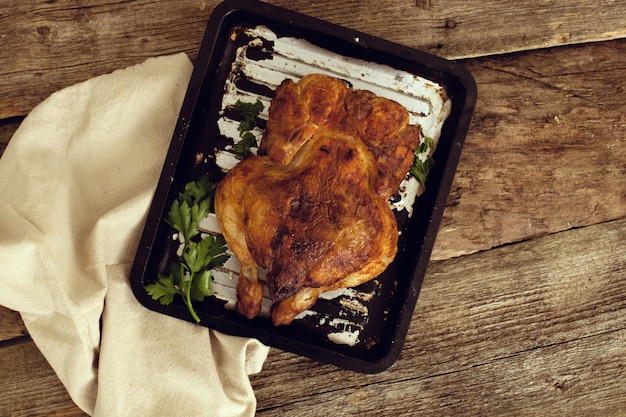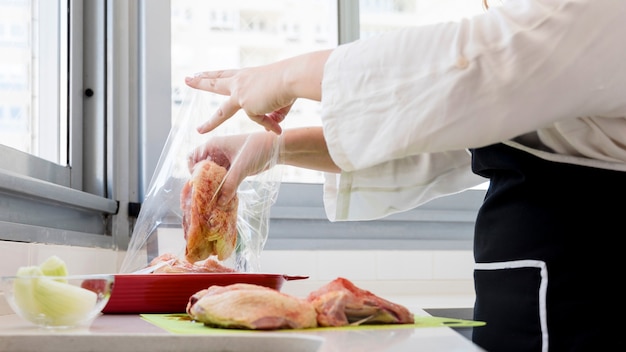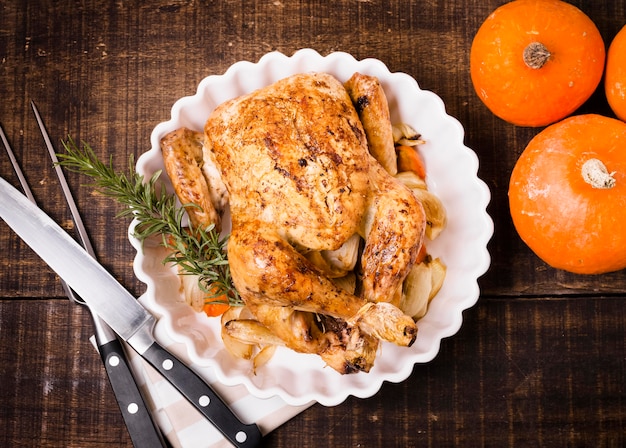(Part 1) The Why Behind Bone-In: It's Not Just a Pretty Bone

Why Bone-In Trumps Boneless
Now, I know what you're thinking: boneless turkey breasts are so convenient, right? They're all nice and neat, ready to pop in the oven. But I'm here to tell you, bone-in is where it's at. That little bone isn't just for show; it's a secret weapon for juicy, flavourful results. Think of it as a natural flavor enhancer, a built-in moisture magnet.The Bone's Magic: More Than Just a Structural Support
That bone isn't just there to keep the turkey breast intact; it plays a vital role in the cooking process. It acts like a natural insulator, preventing the meat from drying out. And get this: the bone helps create a flavorful broth as it cooks, naturally basting the turkey breast from the inside out. You'll end up with a tender, juicy breast that's bursting with flavour.(Part 2) Selecting the perfect turkey Breast: Choosing Your Star

Size Matters: A Turkey Breast That Fits Your Needs
When choosing your turkey breast, remember, size matters! You want to find one that's not too big and not too small, ideally around 4-6 pounds. Anything smaller, and you might be left wanting more, and a larger breast can be a challenge to cook evenly.Knowing Your Turkey: Checking for Quality
Always pick a turkey breast that's firm and has a nice, even color. Avoid any signs of bruising or discoloration. And don't forget to give it a good sniff. There shouldn't be any off-putting smells.(Part 3) The Brine: A Turkey's Spa Day for Ultimate Juiciness

Brining Basics: The Secret to a Tender and Juicy Breast
Here's the truth: brining is not optional. It's a game-changer for achieving that perfectly juicy turkey breast. Think of it like a spa day for your turkey – it rehydrates and tenderizes the meat, resulting in a melt-in-your-mouth experience.Brine Recipe for the Win: A Simple and Flavorful Solution
While there are tons of brine recipes out there, I have a tried-and-true favorite that never fails:- 1 gallon of water
- 1 cup kosher salt
- 1 cup brown sugar
- 1/2 cup lemon juice
- 1 tablespoon dried thyme
- 1 tablespoon dried rosemary
- 1 tablespoon black peppercorns
Combine all ingredients in a large container and stir until the salt and sugar are dissolved. Submerge your turkey breast in the brine, making sure it's completely covered, and refrigerate for 12-24 hours.
(Part 4) The Prep Work: Getting Ready for the Oven
A Clean Slate: Starting Fresh
Before you even think about roasting, you need to give that turkey a good wash. Rinse it under cold water, pat it dry with paper towels, and make sure there's no leftover brine clinging to the skin.The Secret to Crisp Skin: Achieving that Golden Perfection
Here's a little secret for achieving that beautiful, crispy skin: after patting the turkey dry, rub it with olive oil and a little salt and pepper. This creates a delicious barrier that helps the skin brown perfectly in the oven.Butter Up That Bird: A Touch of Luxury for Maximum Flavor
Now, I'm going to admit something: I'm a big fan of butter. It's the ultimate way to add flavor and moisture. Before you pop the turkey in the oven, take a small pat of butter and gently spread it under the skin, all around the breast. It's a touch of luxury that makes a big difference in flavor and tenderness.(Part 5) Roasting to Perfection: The Oven's Role in the Process
Temperature Talk: Setting the Stage for Even Cooking
The oven is your partner in crime, so you need to set it to the right temperature. For a bone-in turkey breast, 325°F (160°C) is the perfect starting point. This gentle heat allows the meat to cook evenly and retain its moisture, resulting in a beautifully cooked turkey breast.The roasting time: A Guide to Timing Your Roast
There's no magic number when it comes to roasting time, but a good rule of thumb is to cook the turkey for about 15-20 minutes per pound. So, if your turkey breast is 5 pounds, you'll need about 1 hour and 15 minutes to 1 hour and 40 minutes.Checking for Doneness: Ensuring a Perfectly Cooked Turkey
You want to make sure your turkey breast is cooked through, but not overcooked. Here's where a meat thermometer comes in handy. Insert it into the thickest part of the breast, avoiding the bone, and aim for an internal temperature of 165°F (74°C).(Part 6) Taking a Break: The Importance of Resting Your Turkey
The Importance of Rest: Letting the Juices Redistribute
This might sound like an unnecessary step, but letting that turkey rest for 15-20 minutes after you take it out of the oven is absolutely essential. It allows the juices to redistribute, creating a much juicier and tender turkey breast.Staying Warm and Cozy: Keeping Your Turkey Toasty
While the turkey rests, cover it loosely with aluminum foil. This will help keep it warm and prevent it from drying out.(Part 7) Carving and Serving: The Grand Finale
Carving with Care: A Skill You Can Master
carving a turkey breast may seem intimidating, but it's a skill that's easier to master than you think. Use a sharp carving knife and slice the breast against the grain. This will ensure the slices are nice and tender.A Festive Table: Presenting Your Feast
Now, the fun part: you've got a juicy, flavorful turkey breast ready to go. It's time to gather your friends and family around the table for a delicious feast. Serve it with your favorite sides, like mashed potatoes, gravy, stuffing, cranberry sauce, and green bean casserole.(Part 8) Troubleshooting Turkey Troubles: Dealing with Common Issues
Dry Turkey Woes: Saving a Slightly Overcooked Bird
Oh, the dreaded dry turkey. It's happened to the best of us. If your turkey breast ends up a bit dry, don't despair. First, check the internal temperature with a meat thermometer. If it's overcooked, there's not much you can do. However, if it's just a bit dry, you can add some moisture back in. You can use a turkey basting syringe and inject some broth into the breast, or you can add a little butter or gravy to the top.A Turkey Too Dark: Preventing Over-Browning
Sometimes, your turkey breast can end up a bit darker than you intended. If this happens, cover it with a loose piece of aluminum foil to prevent it from browning too much.(Part 9) Beyond the Roast: Leftover Turkey Magic
turkey sandwiches Anyone?: Leftovers Done Right
Those leftover turkey slices are practically begging for a sandwich. Add some mayonnaise, lettuce, tomato, and a little bit of your favorite cheese for a delicious lunch or dinner. You can also use those leftover slices to make a delicious turkey salad.turkey soup: A Comfort Classic
Turn those leftovers into a comforting and delicious soup. Use the bones to make a rich and flavorful broth, and add some of the turkey meat, vegetables, and your favorite seasonings for a hearty and satisfying meal.(Part 10) FAQs: Answering Your Burning Questions
What are the best side dishes to serve with a bone-in turkey breast?
The possibilities are endless! Some classic options include mashed potatoes, gravy, stuffing, cranberry sauce, and green bean casserole. You can also get creative with seasonal vegetables like roasted brussels sprouts or sweet potatoes.
How long can I keep leftover turkey breast in the refrigerator?
Leftover turkey breast should be stored in the refrigerator in an airtight container and can last for up to 3-4 days.
Can I freeze leftover turkey breast?
Absolutely! You can freeze leftover turkey breast in an airtight container or freezer bag for up to 2-3 months.
Can I use a different brine recipe?
Of course! There are countless brine recipes out there, so feel free to experiment and find one that you love. Just make sure to follow the basic brine principles, which involve salt, sugar, and a little bit of acid.
What are some tips for keeping the turkey breast moist?
Don't overcook it, and make sure you rest the turkey for at least 15-20 minutes after you take it out of the oven.
How do I make sure the turkey is cooked all the way through?
Use a meat thermometer to check the internal temperature in the thickest part of the breast. It should reach 165°F (74°C).
(Part 11) Wrapping Up: A Turkey Feast for the Ages
Alright, my friends, there you have it. I've shared my top tips and tricks for roasting the most succulent, juicy bone-in turkey breast. It's a journey, but a delicious one. So go forth, get your hands on a beautiful bone-in turkey breast, and make your next holiday meal a turkey feast for the ages.
(Part 12) A Deeper Dive: Techniques and Tips
The Power of Roasting: Understanding the Process
Roasting is a dry-heat cooking method that uses hot air to cook food. This method is perfect for creating a crispy skin on your turkey breast while keeping the meat moist and flavorful.The Art of Basting: Keeping Your Turkey Moist
Basting helps keep your turkey breast moist and flavorful. It involves spooning the juices that accumulate in the roasting pan over the turkey breast during cooking. You can use a basting brush or a spoon.Pan Gravy: Transforming Drippings into Deliciousness
Don't waste those flavorful turkey drippings! Use them to make a delicious pan gravy. After your turkey is done roasting, remove it from the pan and set it aside to rest. Add a tablespoon or two of butter to the roasting pan and whisk in a tablespoon of flour. Slowly whisk in the turkey drippings and bring the gravy to a simmer, stirring constantly until it thickens. You can add salt and pepper to taste.Spatchcocking: A Game-Changing Technique
Spatchcocking is a technique that involves removing the backbone from a whole chicken or turkey and flattening it out. This allows for faster and more even cooking, as well as a crispier skin. You can apply the same technique to a turkey breast, removing the bone and flattening it out, which will help it cook more evenly and create a delicious, crispy skin.(Part 13) Beyond the Traditional: Innovative Turkey Breast Dishes
smoked turkey Breast: A Taste of the South
If you're looking for a unique twist on turkey breast, consider smoking it. This process infuses the meat with a deep, smoky flavour that's simply irresistible. You can smoke your turkey breast in a smoker or even in your grill.Turkey Breast with Herbs and Citrus: A Refreshing Flavor Combination
A bone-in turkey breast is a blank canvas for delicious flavors. Try incorporating fresh herbs like rosemary, thyme, and sage, along with citrus zest like lemon or orange for a bright and refreshing flavor combination.(Part 14) The Final Word: A culinary adventure Awaits
Remember, the joy of cooking is in the journey, not just the destination. Experiment, get creative, and most importantly, have fun! I hope this guide has given you the confidence and inspiration to create a stunning, juicy, and flavorful bone-in turkey breast for your next gathering. Happy cooking!Everyone is watching

Corn on the Cob: The Ultimate Guide to Perfectly Cooked Ears
Healthy MealsAh, corn on the cob. Just the name evokes images of sunny days, barbecues, and that sweet, juicy flavour that ...

Perfect Pork Roast Oven Cooking Time: A Guide to Delicious Results
Healthy MealsThere's something truly satisfying about a perfectly roasted pork. The aroma alone is enough to make your mout...

Ham Cooking Time: How Long to Bake, Smoke, or Boil a Delicious Ham
Healthy MealsAh, ham. It's a classic, isn't it? A real crowd-pleaser, especially around holidays. And when done right, it'...

Scallops: The Ultimate Guide to Perfect Cooking
Healthy MealsAh, scallops. Those delicate, sweet, and utterly delicious morsels of the sea. They hold a special place in my...

Spaghetti Squash: The Ultimate Guide to Cooking and Serving
Healthy MealsRemember that time you saw spaghetti squash at the supermarket, looking all bumpy and strange, and thought, "W...
